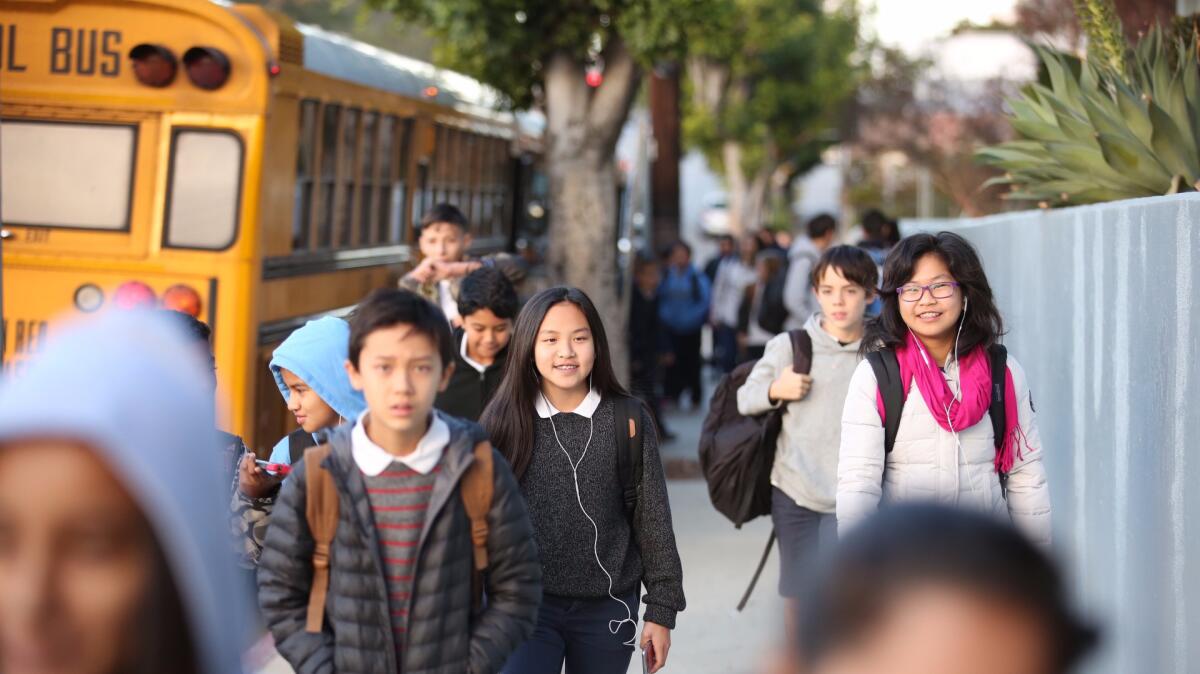Three things to know about how L.A. schools are using your money

On Tuesday, the Los Angeles Unified School District approved $7.6 billion in spending for the upcoming fiscal year. But where does that money go, and who decides how to spend it? Here are a few things to know about the 2016-17 budget.
1. Most of the money goes to salaries and benefits
Most of the general fund money— about $6.1 billion—goes toward salaries and benefits for certificated employees (mainly in the classroom) and classified employees (mainly out of the classroom).
In 2015-16, the school district had more than 60,000 full-time employees, including teachers, principals and school support staff who aren’t in the classroom. In the coming year, the district will pay the balance of a two-year, 10% raise for teachers and other employees.
The district will also add more elective teachers to middle schools and high schools, and introduce teachers to make class sizes smaller for 55 elementary schools with the highest needs.
2. The district has to give more resources to high-needs students.
The district probably will receive about $5.4 billion of its budget from the state through the Local Control Funding Formula, which gives extra money to districts based on the number of students who need extra support in school, including low-income students, foster youth and English learners. (The state hasn’t passed its budget yet, so this is projected spending from the district.)
A major purpose of the new funding strategy, which began in 2013-14, is to give spending power to districts and communities to decide what their needs are. The district is required to develop a local control accountability plan to determine goals, and must consult with parents and students to understand how they want the money spent and what changes they would like to see.
L.A. Unified’s goals vary from increasing the district’s graduation rate to increasing the percentage of students passing Advanced Placement exams and filling out college financial aid forms.
Supt. Michelle King said her focus for this budget was equity. Not all students in the district receive the same educational opportunities yet, she said during Tuesday’s meeting, but increasing funding and programs for those in need will help. This budget devotes millions more to early education, foster students, arts programs, magnet schools, dual-language learning programs and restorative justice, an alternative discipline approach.
At Tuesday’s board meeting, representatives from the district-level English learner advisory committee and the district’s parent advisory committee said they want more than what’s in this budget: better transportation options, more transparency about the outcomes of programs, more consultation with parents to decide how principals spend discretionary funding for their schools, and better efforts to lobby for more state funding for the schools.
3. There’s a fight over how to fund programs for students with disabilities
One group that does not receive extra money from the state through the state’s new funding formula: students with disabilities. The district spends about $1.5 billion on these students each year. These services are called special education, and state and federal funds only cover a limited portion of the district’s needs, leaving the school system to find the rest elsewhere.
The district has been directing some of the funds designated for English learners, foster youth and poor students to pay for the special education services these students receive. A South L.A.-based advocacy group sued the district and filed a complaint with the California Department of Education, alleging that the district isn’t using the money properly. They say the state money must pay for additional programs for these students and not be used to cover the costs of services these students already are receiving.
In May, the state Department of Education sided with the advocates and said that the district needs to explain or reallocate up to $450 million of the money it was planning to use on special education programs, starting in 2017-18. District officials have said they will challenge the decision, and warned that if they’re not able to use that money as planned, they might have to increase class sizes and lay off hundreds of employees.
District representatives also are lobbying state lawmakers to change the formula so that the district’s use of state funds would be allowed.
Staff reporter Howard Blume contributed to this report.
Reach Sonali Kohli at [email protected] or on Twitter @Sonali_Kohli.
ALSO
Fund set up to raise money for L.A. Unified merges with group starting two charter schools
Supreme Court upholds use of affirmative action at universities
How UCLA is boosting campus diversity, despite the ban on affirmative action
More to Read
Sign up for Essential California
The most important California stories and recommendations in your inbox every morning.
You may occasionally receive promotional content from the Los Angeles Times.











